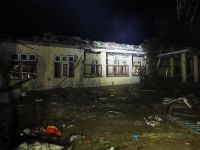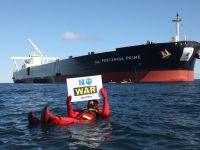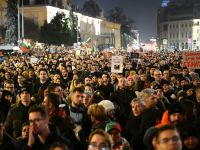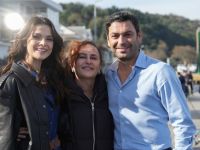OVERVIEW
Minister of Energy and Industry: Sheikh Abdullah bin Hamad al-Attiyeh
Proven Oil Reserves (1/1/00): 3.7 billion barrels
Oil Production (1999E): 806,000 barrels per day (bbl/d), of which 659,000 bbl/d was crude oil
OPEC Crude Oil Production Quota (effective 7/1/00): 658,000 bbl/d of crude oil (not including condensate)
Natural Gas Liquids Production (1999E): 111,000 bbl/d
Oil Consumption (1999E): 45,000 bbl/d
Net Oil Exports (1999E): 760,000 bbl/d
Crude Oil Refining Capacity (1/1/00): 57,500 bbl/d
Natural Gas Reserves (1/1/00): 300 trillion cubic feet (Tcf)
Natural Gas Production (1998E): 690 billion cubic feet (Bcf)
Natural Gas Consumption (1998E): 522 Bcf
Net Natural Gas Exports (1998E): 168 Bcf
Electric Generation Capacity (1/1/98): 1.4 gigawatts
Electricity Production (1998E): 6.7 billion kilowatthours
OIL AND GAS INDUSTRIES
Organizations: Qatar General Petroleum Corporation (QGPC)—exploration and production; National Oil Distribution Company (NODCO)—refining and distribution; Qatar Petrochemical Company (QAPCO)—petrochemical production; Qatar Fertilizer Company (QAFCO)—fertilizer production; Qatar Liquefied Gas Company (Qatargas) and Ras Laffan LNG Company (Rasgas)—production and marketing of liquefied natural gas (LNG)
Major Foreign Oil Company Involvement: BP Amoco Arco, Chevron, Enron, Exxon, Gulfstream, Maersk, Marubeni, Mitsui, Mobil, MOL, Occidental, Phillips Petroleum, TotalFinaElf, Wintershall
Major Ports: Umm Said, Ras Laffan
Producing Oil Fields (production—bbl/d)(1998E): Dukhan (275,000), Id al-Shargi North Dome (120,000), Bul Hanine (80,000), Maydan Mahzam (50,000), al-Shaheen (100,000), al-Rayyan (32,000), and al-Khalij (30,000)
Major Pipelines: Dukhan-Umm Said, an offshore network connecting Halul Island to al-Khalij, Bul Hanine, and Maydan Mahzam, and Das Island (U.A.E.)-al-Bunduq
Major Refineries (capacity—bbl/d): Umm Said (57,500)
Qatar contains the third largest natural gas reserves and the largest non-associated gas field in the world. Qatar is also emerging as a major exporter of liquefied natural gas. An OPEC member, Qatar exports over 600,000 barrels of oil per day.
GENERAL BACKGROUND
Since 1995, Qatar has been ruled by Sheikh Hamad bin Khalifa al-Thani, who took power in a palace coup against his father. Sheikh Hamad has implemented several changes in policy, including a limited political liberalization creating an elected council and giving women the right to vote. In the economic sphere, Qatar has suffered from many of the same problems as other oil-dependent Persian Gulf states, especially the need to diversify economic development beyond crude oil exports and scale back the generous state subsidies for consumers, which date from the oil boom of the 1970s and early 1980s.
Qatar's real gross domestic product (GDP) grew at an annual rate of 3.3 percent in 1999, after posting growth of only 0.3 percent in 1998 due to low oil prices. The projected real GDP growth rate for 2000 is 4.6 percent, and around 5 percent after 2000, based mainly on rising production and sales of natural gas. Inflation in Qatar remains low, at 2.2 percent for 1999 and projected at 2.3 percent for 2000.
Qatar's policy of economic diversification has led to a surge in investment in projects for the export of liquefied natural gas (LNG) and petrochemicals. The government expects that it will be able to earn more per barrel of crude oil produced if it can export refined products and petrochemicals, as well as create private sector jobs—in a country which has been heavily dependent on government ministries to provide employment for the population.
The main short-term economic problem for Qatar is servicing its debt, which rose from under $5 billion to over $10 billion between 1994 and 1996, and surged to nearly $12 billion in 1999. Qatar accumulated this debt largely for infrastructure investment in oil and gas projects, which sharply increased Qatar's oil production capacity, construction of facilities for the export of LNG, and petrochemical plants. The increase in revenues which was expected, however, was interrupted by low crude oil prices in 1998 and early 1999, and by the Asian financial crisis. The recovery in prices for crude oil, as well as the start of deliveries from the RasGas LNG project, have greatly eased Qatar's debt payment burden.
Qatar recorded a budget surplus for the 1999/2000 fiscal year, which ended in March 2000. This was the first budget surplus in several years. The budget for the 2000/2001 fiscal year will be in surplus if Qatar's crude oil continues to sell for an average of at least $15 per barrel.
OIL
Qatar has proven, recoverable oil reserves of 3.7 billion barrels, of which about 2.2 billion barrels are located in the Dukhan field, Qatar's only onshore field. The remaining proven 1.5 billion barrels are held in six offshore fields Bul Hanine, Maydan Mahzam, Id al-Shargi North Dome, al-Shaheen, al-Rayyan, and al-Khalij. Qatar contains crude oil with gravities in the 24o-41o API range. The country's two primary export streams are Dukhan (41o API) and Marine (36o API) blend. Despite the country's significant oil production and reserves, oil accounts for less than 15 percent of domestic energy consumption. Qatar exports almost all of its oil production to Asia, with Japan its largest customer. In 1999, net oil exports totaled 760,000 barrels per day (bbl/d), and production has risen in mid-2000 as a result of OPEC's decision to increase production quotas at its March 2000 meeting.
In 1999, Qatar produced 806,000 bbl/d of liquids, up from 782,000 bbl/d in 1998, and only 466,000 bbl/d as recently as 1994, before Qatar began its rapid expansion of production capacity. As of May 2000, Qatar's monthly crude oil production was averaging 680,000 bbl/d. The country also produces a significant amount of lease condensate and other natural gas liquids (NGLs), both of which fall outside Qatar's OPEC crude production quota of 658,000 bbl/d, which became effective July 1, 2000.
Following the coup in 1995, Qatar initiated a number of new policies aimed at increasing oil production, locating additional oil reserves before existing reserves become too expensive to recover, and investing in advanced oil recovery systems to extend the life of existing fields. To accomplish this, the government, in recent years, has improved the terms of exploration and production contracts and production sharing agreements (PSA). The improved terms are designed to encourage foreign oil companies to improve oil recovery in producing fields and to explore for new oil deposits.
Onshore Development:
In March 1998, Qatar signed an onshore oil exploration agreement with Chevron Corporation. It is a five-year PSA and exploration agreement, covering a 4,209 square-mile area known as Block-2. Block-2 covers virtually all of the Qatari peninsula except for the Dukhan field. Seismic surveys were conducted in 1998, and drilling commenced in 1999. Chevron also holds offshore Block-1 jointly with Hungary's MOL.
Offshore Development:
One of Qatar's newer oil fields is al-Rayyan, operated by BP Amoco, which recently acquired Atlantic Richfield Corporation (Arco). Arco took over as operator from Wintershall and began exploration in September 1995. Wintershall, British Gas, and Gulfstream Petroleum also own significant shares. The field came on stream in November 1996, producing 20,000 bbl/d of heavy oil from four wells. It lies in offshore Block-11 at the southern edge of the North Field near Ras Laffan. The PSA for the field was signed on July 16, 1997. Al-Rayyan has been producing about 25,000 bbl/d in recent months, and BP Amoco and its consortium partners are investing in further development of the field which will bring its production capacity up to 60,000 barrels per day. The field eventually will have five production wells to tap most of the reserves in place, as well as one delineation well.
Qatar's latest offshore oil field to come onstream is al-Khalij. Production began in March 1997, after five years of exploration and appraisal work, at an initial rate of 6,000 bbl/d. Al-Khalij is located in Block-6, along Qatar's maritime border with Iran, and to the east of the North Field. Development of the field had been delayed since 1991 as Elf Aquitaine Qatar, the field's operator, sought improved production sharing terms from Qatar General Petroleum Corporation (QGPC). In October 1997, Elf increased production to 20,000 bbl/d. Production in early 2000 was running at 32,000 bbl/d. Elf expects to eventually raise production further to 50,000-60,000 bbl/d. Al-Khalij produces a medium/sweet (28o API) oil with about 1 percent sulphur. The oil is piped to Halul Island for processing and transportation. Elf holds a 55 percent interest in the 25-year PSA, with an option for a five-year extension. The remaining 45 percent interest is held by Italy's Agip.
Maydan Mahzam became operational in 1965, and its production is currently about 75,000 bbl/d, which is down significantly from its peak. However, QGPC is currently undertaking a renovation intended to extend the life of the field. This work includes plans for 37 new wells over the next decade.
Bul Hanine came on line in 1973, producing well over 100,000 bbl/d, but production began falling off in the early 1990s. Output fell to 120,000 bbl/d in 1991, 90,000 bbl/d in 1993, and 70,000-80,000 bbl/d currently. Development plans to boost production include drilling 86 new wells, and QGPC recently announced a tender for work related to gas-reinjection to maintain pressure in the field. Bul Hanine holds approximately 700 million barrels of recoverable reserves.
Al-Shaheen, operated by Maersk Oil Qatar of Denmark, has become one of Qatar's productive oil fields, with production of around 150,000 bbl/d. Located in Block-5 about 43 miles off Qatar's northeastern coast, al-Shaheen produces a sour (29o-33o API) oil with 1.7 percent-2 percent sulphur. The field is thought to be linked to a section of the North Field.
Id al-Shargi North Dome (ISND), first discovered by Shell in 1960 and now operated by Occidental Petroleum (Oxy), lies 59 miles east of Qatar's northern tip. In 1994, the field was producing 12,000 bbl/d when Occidental signed a 25-year PSA with QGPC, agreeing to invest $700 million in field development, reservoir repairs, gas and water injection systems, and further exploration. Recent output from ISND has reached 135,000 bbl/d. Production is expected to surpass 150,000 barrels per day in 2001.
In December 1997, Occidental signed another PSA with QGPC to develop the Id al-Shargi South Dome (ISSD) oil field. ISSD is located 15 miles from ISND, and Oxy will operate ISSD as a satellite of ISND, keeping overall per-unit operating costs lower. The field came onstream in November 1999, and is expected to reach production of 50,000 bbl/d by the end of 2000. Occidental's ownership interest in ISSD is 44 percent, and the company plans to invest $450 million during the life of the project, with $400 million to be spent over the first five years. ISSD is estimated to contain recoverable reserves of 200 million-300 million barrels.
A longtime dispute has existed between Qatar and Bahrain over their rights to waters between them in the Persian Gulf and ownership of the Hawar Islands. The dispute has been submitted to the International Court of Justice (ICJ) in the Hague, and oral arguments in the case took place in June 2000. A decision is expected before the end of 2000. Some analysts suspect that the oil deposits of Qatar's onshore Dukhan field may extend northward to the Hawar Islands and waters offshore.
Downstream:
Qatar's National Oil Distribution Company (Nodco) is upgrading its refinery at Umm Said. The upgrade will increase capacity from 57,500 bbl/d to 83,000 bbl/d. A 30,000 bbl/d condensate refining unit also is being built on the same site. The projects are expected to be completed by the end of 2001.
In March 1997, QGPC signed a memorandum of understanding (MOU) with the foreign partners of Qatar Liquefied Natural Gas Company (Qatargas) and Ras Laffan Liquefied Natural Gas Company (Rasgas), providing for construction of a $400-million, 80,000-bbl/d condensate refinery at Ras Laffan. After its proposed completion in 2002, the plant will process condensate from the two companies' North Field developments. Condensate streams from the North Field contain high levels of mercaptan sulfur compounds and consequently are unable to be processed at most refineries.
In November 1997, Phillips Petroleum Company signed an $1.1-billion deal with QGPC to build a petrochemical plant, Q-Chem. The plant will have the capacity to produce 500,000 tons per year of ethylene and 467,000 tons per year of polyethylene, including high-density and linear low-density polyethylene. QGPC holds a majority 51 percent stake in the project, and Phillips holds the remaining 49 percent stake. Bank financing for the project was secured in mid-1999. The plant is expected to begin exports in 2002.
NATURAL GAS
With proven reserves of 300 trillion cubic feet (Tcf), Qatar's natural gas resources ranks third in size behind Russia's and Iran's. Most of Qatar's gas is located in the North Field, which contains 380 Tcf of in-place and 239 Tcf of recoverable reserves, making it the largest known non-associated gas field in the world. In addition, the Dukhan field contains an estimated 5 Tcf of associated and 0.5 Tcf of non-associated gas. Smaller associated gas reserves also are contained in the Id al-Shargi, Maydan Mahzam, Bul Hanine, and al-Rayyan oil fields. The Qatari government believes that the country's economic future lies in developing this vast gas potential. Currently, Qatar has two liquefied natural gas (LNG) exporters: Qatar LNG Company (Qatargas); and Ras Laffan LNG Company (Rasgas).
The Qatargas downstream consortium comprises QGPC (65 percent), Total (10 percent), Mobil (10 percent), Mitsui (7.5 percent), and Marubeni (7.5 percent). In December 1996, the Qatargas venture delivered its first shipment of LNG to Japan. The Qatargas LNG plant consists of three, 2-million-ton-per-year (Mmt/y) (97 billion cubic feet—Bcf) trains. The third train was completed in 1999. Qatargas has plans to add a fourth train by 2002.
Rasgas is Qatar's second LNG project. The two major shareholders in the project are QGPC and Mobil. Rasgas consists of two 2.5-Mmt/y (122 Bcf) trains. The first train was completed in early 1999, and loaded its first cargo in August 1999 for South Korea's Kogas, which has a supply contract. The second train came onstream in April 2000. A tender for planned third and fourth trains is planned for late summer 2000.
In May 2000, ExxonMobil and QGPC signed a final development and production sharing agreement for the North Field. The Enhanced Gas Utilization (EGU) project will develop upstream infrastructure in a portion of the field for domestic use, export to neighboring Persian Gulf states, and use as a feedstock for petrochemical projects. The initial phase of the project will produce 500 million cubic feet per day (Mmcfd), with eventual capacity slated to rise to 1.75 Bcf/d.
Qatar's original markets for its LNG exports were Japan and South Korea, the world's two largest LNG importers. India also has become a major market for Qatari LNG. While Enron cancelled its LNG plant, which was to supply its Dabhol power plant in India, RasGas signed an agreement in July 1999 to supply 7.5 Mmt/y (365 Bcf/y) of LNG to Petronet, a gas distribution consortium in India, beginning in mid-2003. CMS Energy of the United States also has purchased some spot cargoes of Qatari LNG.
Another significant proposed project will tie Qatar into the United Arab Emirates (UAE) Dolphin Project, an integrated gas pipeline grid for Qatar, UAE, and Oman, with a possible subsea connection linking Oman to Pakistan. The United Offsets Group (UOG), a UAE state owned corporation backing the project, signed preliminary memorandums of understanding with Qatar, Oman, and Pakistan in June 1999. Mobil also signed a preliminary agreement in June 1999 for the gas supply from Mobil's production capacity in the North Field. The total project is expected to cost $10 billion, including costs associated with the development of more extensive gas distribution networks in the UAE and Oman. Qatar initially will sell around 800 Bcf/y of North Field gas, starting in 2002, transported through a pipeline linking the North Field to Abu Dhabi in the UAE. Construction is to start in 2001, and links between Abu Dhabi, Dubai, and Oman should be completed by 2003. UOG announced in March 2000 that TotalFinaElf and Enron had been selected to implement the project, and each will have an equity stake of 24.5 percent. TotalFinaElf will develop its concession in the North Field to provide gas, while Enron will focus on pipeline development. The Dolphin Project has been driven in part by the desire of UAE and Oman to use more natural gas for power generation and industrial use, and the decline in their own production of associated natural gas due to OPEC crude oil production cuts. Pakistan's participation is doubtful, due to its financial condition and the possibility of imports from Iran.
Kuwait also has held discussions with Qatar about the purchase of Qatari gas. A preliminary agreement was signed for gas sales in May 2000, which would source the gas from ExxonMobil's North Field holdings. Details of the project and volumes are still being discussed.
ELECTRICITY
Qatar currently has an electric generation capacity of 1,445 megawatts (MW), and produces 6.7 billion kilowatthours of electricity per year. Most of the country's power plants are gas-fired. The residential sector accounts for 80 percent of Qatar's electricity consumption. In response to recent financial pressures, the Qatari government announced in 1999 that it would limit the provision of free electricity to Qatari-citizen households, with payment required for consumption above a set threshold.
In May 2000, the Qatari government took a major step towards privatization of its power sector. Assets owned by the Ministry of Electricity and Water (MEW) were transferred to the Qatar General Electricity and Water Corporation (QEWC). QEWC is 57 percent controlled by local investors and 43 percent controlled by the government.
The Ras Abu Fontas B-plant is the country's largest and newest power and water desalination plant. It has an electric generation capacity of 650 MW and water output of 33 million gallons per day. QEWC has solicited bids for a planned 400 MW expansion of the plant, and an award is pending.
QEWC issued a tender in May 2000 for the proposed Ras Laffan Independent Power and Water Project ("Ras Laffan IWPP"), which will be co-located with the Ras Laffan gas and industrial complex. The plant will have a generating capacity of 750 MW when completed, with the first 400 MW scheduled to be operational by 2003. The successful bidder will take a 55 percent stake in the project, with QEWC holding 25 percent.
Sources for this report include:
United States Energy Information Administration.
© 2000 Mena Report (www.menareport.com)







